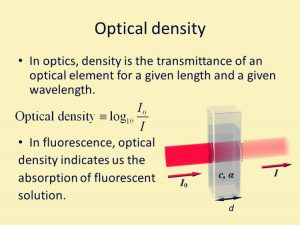

It is easy to get optical density and absorbance confused since both measure the amount of light "absorbed" when light passes through an optical component, but the two terms have some subtle differences. Though optical density and absorbance both measure the absorption of light when that light passes through an optical component, these two terms are not the same. Optical density measures the amount of attenuation, or intensity lost, when light passes through an optical component. It also tracks attenuation based on the scattering of light, whereas absorbance considers only the absorption of light within the optical component. Both optical density and absorbance can be tracked through the use of a spectrometer.
Optical Density
Optical density, sometimes written as OD, is a measurement of a refractive medium or optical component's ability to slow or delay the transmission of light. It measures the speed of light through a substance, affected primarily by the wavelength of a given light wave. The slower that light is able to travel through a given medium, the higher the optical density of the medium.
Absorbance
In contrast to optical density, absorbance measures the ability of a refractive medium or optical component to absorb light. This sounds incredibly similar but is not quite the same. Where optical density measures the speed of light passing through a medium, absorbance measures how much light is lost over the course of light's passage through the given medium. Optical density also takes the scattering, or refraction, of light into consideration where absorbance does not.